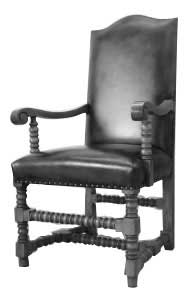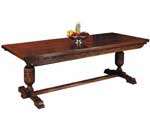|
|
The "New" Concise History is under construction here. Please bear with us as we improve our educational sections.
A Concise History of American Period Furniture
By Stanley D. Saperstein
 Jacobean, 1603-1688 Jacobean, 1603-1688
The early Jacobean period inspired much early American furniture. The period is named after James I, and covers the right of both James I and Charles I (1603-1649). The middle of the Jacobean period is known as the Commonwealth Style (1649-1660). The late Jacobean (1660-1688) is called the Carloean, after Charles II.
Characteristics of these styles are as follows: Almost all Jacobean furniture is made of oak, a wood well-suited to the massive, sturdy style. Almost all flat surfaces on chairs, chests, etc. are carved in low relief. The method of construction was very simple; almost all mortise and tennon joints, held together with pegs. The lines are square and rectangular. Some veneering and inlay were used, and many pieces were painted. Upholstering materials were leather, tapestries, crewelwork, wool, linen, silk, and velvet. The most outstanding characteristics were heavy turning knobbed bun feet on chests and tables. Spiral turning was also very popular. Tables were rectangular in shape, with small melon ball turning on the legs. Gate-leg circular tables were introduced at this time as well.
Almost all American furniture made in the colonies copied English furniture styles. Most of the American primitive furniture was produced during this period by colonists to made do, because there were few skilled cabinetmakers in the colonies.

TheConciseHistoryofEarlyAmericanFurniture.PDF
Download a PDF Version of The Concise History
|



 Jacobean, 1603-1688
Jacobean, 1603-1688